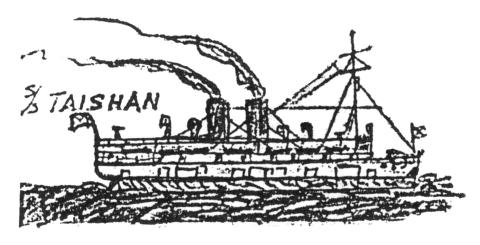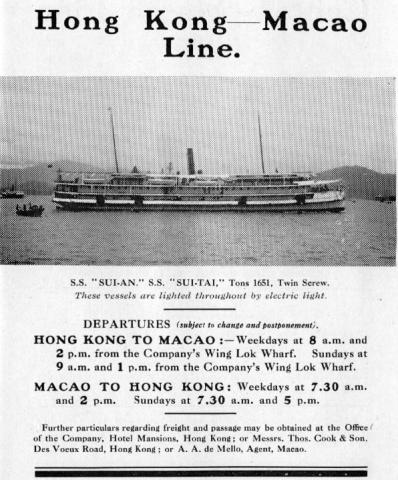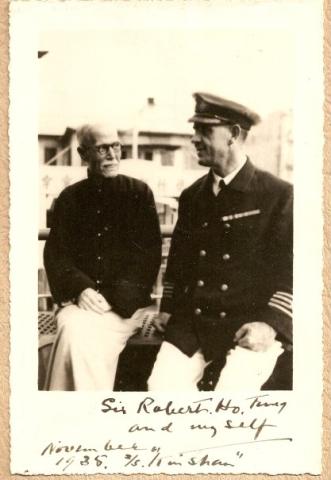This week's newsletter is an extract from Captain Thomas Pritchard's memoirs. He wrote them, and drew the sketches, while interned by the Japanese in Stanley Camp. Sadly he died in the Camp in 1944, but a friend kept the document safe, and delivered it to Captain Pritchard's family in North Wales after the war. If you're interested in ships and the sea, I recommend you read the full memoir, which starts with him working on sailing ships in the 1890s.
In June 1924 I joined the Hong Kong Canton & Macao Steamboat Company River Steamer but considered to be the best (one of the best) Company on the coast - home leave every five years, the wages similar to B.&.Swires ((Butterfield & Swires)), safe navigation money, etc to the Captains. There were five steamers two on the Hong Kong Macao run and three on the Hong Kong, Canton run, running in conjunction with the B.& S. Co. In fact B. & S. controlled it and their Superintendent supervised the ships. I joined the Paddle Steamer Honam to commence with, an old Steamer but she could travel about 16 knots. I was 2nd Officer but the ships were well kept and good food, bed linen, towels etc. - in fact - as good as being in a 1st. Class Hotel.
It did not take me long until I was promoted to Chief Officer of the “Kinshan" and later to the s/s "Lung Shan" under Captain Bell Smith. The vessel was almost a new ship when I joined her fitted up like a 1st Class hotel hot & cold water throughout.
In 1925 (about June) a strike broke out in Hong Kong, all Chinese servants and workmen came out, all the Coast and River steamers were laid up from Shanghai to Canton - the ?????? (some of them) started to run up in the North in the month of October.
In July I had very bad news from home my little girl Ellen aged 10 passed away after an operation for peritonitus a sad blow. The death of my mother soon followed and later Miss Bannerman, Fron, Abererch passed away. She had been a great friend and help to me for many a year. Seeing everything was upset at home I went home on shore leave. I found my wife very low spirited and decided to have her shifted to Pwllheli to live before going away again so I bought "Talarfor" South Beach and shifted there as soon as possible- although the house was much too big for such a small family however I stayed home for two months and went away again.
Sailed from Liverpool in a Blue Funnel Steamer for Hong Kong and when I arrived in Hong Kong the strike was still on and some of the ships laid up. I was put on the "Kin Shan" on the Macao run the "Honam" by this time had been sold and broken up and the s/s "Taishan" had been launched and was running to Macao. A beautiful steamer, but had very bad luck to start with running to Macao was poor trade for her running, of course, at a great loss - however the strike continued until until 1927. Capt. McKinnon went home sick, and I was shifted to s/s Taishan as Chief Officer.
In 1927 strike eased down a bit and the ships "Lungshan" and "Taishan" commenced to run to Canton but could not carry passengers or cargo either way and the situation was very delicate, the Chinese had all turned Bolsheviks through the Russian Red propaganda only by slow strides the position had become normal and the people had found that they had made a mistake having lost their jobs etc. Chang Kai Shek had advanced from Canton to the Yangtse taken all the chief cities on the river including Shanghai however things gradually became normal and Europeans were again respected and Chang Kai Shek threw all the Russians out and did away with Red propaganda. However trade with Canton was never the same again and the ships continued to lose money no foreign cargo due to the high tariff on the Foreign goods.
In 1931 our Secretary Mr. J. Arnold retired due chiefly to the Company having passed into the hands of Sir Robert Ho Tung and his other Chinese directors they thought that they could do better than the European directors but it soon proved they could not as good as European companies such as the P. & O., Blue Funnel, and C.P.R. stopped almost altogether to send their cargo by one Company. Our European Directors were the heads of the P. & O. heads of B. & S. heads of Union Insurance head of Dodwells & Co. and were people of influence. Not only that the new directors started to meddle with our home leave and pay and instead of the pension they adopted the provident fund which I hold but little hope in now.
In March (12th) 1931 I had a collision with the s/s Venezia when in the s/s SuiTai bound from Macao to H. Kong and Venezia going the opposite way and in a position off Cheong Chan Leong the two met in thick fog - Sui Tai collided with her by hitting her stern on just before the Bridge on the Port side she had a narrow escape from sinking - Sui Tai's bow was badly smashed. However I won the case and the Venezia's Company had to pay his own damage and ours, (ours was about $14000). It broke them and she only ran for a short time after that.
I vent home on leave in December 1934 - my second leave. Sailed on the 29th December in a P.& O. steamer. My first leave was in June 1929 via Canada went by Empress of Russia to Vancouver and cross country to Montreal across the Canadian Rockies a beautiful sight also across the Prairies 5 days going across just like crossing the wide ocean nothing to be seen but a farm here and there, not even a tree for hundreds of miles and the weather was fine. I had to stay in Montreal for two days to await a steamer for Liverpool. I crossed in the Militin C.P.R. Steamer and somehow think I was in her as Commodore of Convoy in the last war (I brought half of the Convoy from Halifax other half from New York). However I arrived in Liverpool on Saturday evening and got in a train for home on Monday morning, During my home leave my Father-in-law (Rev. H. Davies) died at the age of 79, buried in Abererch.
During my leave quite a lot of changes had happened in the Company. I was put in the s/s "Taishan" on my return. We gave a farewell dinner to Mr. Arnold in the s/s "Kinshan’ and a present of a model Chinese junk. Mr. Ellam was made acting Secretary and Mr. Arnold sailed for Canada on retirement. Mr. Ellam died about 1933 and Mr. Luz took his place.
Whilst on home leave (last one) in 1935 I bought a small motor car I think a Morris 7, 2nd. hand, gave £40 for it quite a good little car and was well worth it. By now I am extremely pleased that I bought it. With it I was able to see more of Wales than ever I did in my life before. I saw some beautiful places and took my family about with me and they enjoyed it. My longest run in it was to Wrexham and back the same day. Before leaving home I sold it for £45 which was I think a much better car than it was when I got it.
I left home in August (while home that time I spent ten days with my brother Jack at P. Talbot quite a nice time there and they were nice to me - on August Bank Holiday we went to Pwllheli by Jack car lovely drive [Armstrong Sidley Car] started 6am, arrived at Pwllheli 10pm, lovely drive via Wye valley that way) to sail in the P. & O. Steamer “Citral" on August 16th arriving in Hong Kong in September some time. I joined the s/s Kinshan.
Mr. Luz was now Secretary and he was bothered about shifting some of us on the night run as Captain Lake Was very dissatisfied. However he failed to do so until the Company made a rule that no Captain was to be on the Macao night run longer then 6 months - and I and others were shifted around, me to the Sui Tai but not for long on account of Captain Thomson resigning. There was another shift around and I was put on the Taishan again. So we were again settled down for a while until the "Lung Shan" and the "Sui An" were laid up. Officers and crews of these vessels were paid off including Captain Hadden and Captain Hales officers Macon and Bolt and some 2nd officers the names I have forgotten. However Captain Hadden died after an operation in about a month’s time.
In 1937 Japan made war on China and trade to Canton became difficult due to the Barrier thrown across the Canton River but there was plenty of cargo and big freight and the ship was paying well. In the winter of 1938 (in October) the Japanese captured Canton after having bombed it day and night for about 12 months. I was in Canton in the "Kinshan" and was held there for about 6 weeks. The city was almost all destroyed by fire, all trade from H.Kong to Canton was now stopped and when I got back to Hong Kong I was put back in the “Taishan" after her yearly docking and we carried on this run through Cap-si-mim pass until the European War broke out Sept, 1939. Then we were only allowed to use Cap-si-mim when we used the channel between Lantau Island and another small island just off it inside the Brothers - not much water in the Channel on low tide - otherwise the official Channel for Macao Steamers now was the East Lamma Channel outside Chuen Chan Island which proved to be very boisterous at tines with high running seas straining the vessel badly, besides River Steamers are not built strong enough to heavy rolling in the open sea. However every Captain protested about it and wondering why the small Channel by Lantau could not be used but of no avail.
The "Lungshan” and "Sui-an" were sold to Shanghai shortly after they were laid up, and "Sui Tai" sold just after to Shanghai. The Company bought a little motor steamer named the Lee Hong afterwards renamed the "Ching Shan" which proved a failure in every way. She was no use for Cargo or Passenger on any run. From 1938 the company had only one vessel running to Macao sometimes "Taishan" and sometimes "Kinshan" was used until finally they only ran the s/s "Taishan" on the night run.
Many thanks to Captain Pritchard's grandson Huw for sharing these memoirs with us.
If any readers have family memoirs of life in Hong Kong you can share with us, they'll be very gratefully received.




Comments
Children on board the Sui-an
I've previously posted a photo of my small Warren cousins on board the Sui-an in about 1928 at http://gwulo.com/atom/23937
Jill
Appreciation
Thank you for this wonderful article. I have many fond memories of traveling to and from Macau as a child with my parents. Even after the Hydrofoils were available we continued to take the ferries. It was a four hour journey as opposed to 45 minutes but I never regretted one minute of it. Especially when the Macau had a strip show. It was the first one I'd ever seen and I think my eyes popped out. I recall when there was a smallpox outbreak the medical authorities came aboard in Macau and inspected everyone's certificates. If you didn't have proof you were vaccinated then and there. There was a lot of angry people who hadn't bothered to bring there certificates along. (They were available from the Port Health Authority and I believe I still have mine somewhere).
Thanks again, well worth reading.
re: Appreciation
Stewart, glad to hear you enjoyed the article. You might also enjoy the page "Steamliners to Macao", which has more reminiscences and photos about this topic.
Regards, David
S.S. Kinshan
For those river steamboat buffs who would like to see pictures of SS Kinshan ( 金山 ), I direct you to the University of Bristol's NEW* website : "Historical Photographs of China" where you can view two photos of Kinshan berthed at Canton ;
http://www.hpcbristol.net/visual/sw04-050
http://www.hpcbristol.net/visual/sw04-055
* Note: Their webste has recently been upgraded and the former link is now redundant ( Remember to revise your bookmarks! ) The new link is http://www.hpcbristol.net/
P.S.
David, I was very happy to see that one of my earliest posts of scannned images on this forum ( an advertisement for the SS Honam ) has proved useful for illustrating this very interesting diary extract.
Sui Tai
Demise of the "Tai Shan"
Mention is made in the China Mail dated 7 October 1950 of the Notice in the Government Gazette calling for the purchase of the river steamer, "Tai Shan" lying in Sai Wan Bay.
"Long before the Pacific War broke out, as part of the Colony's defence measures the Royal Navy stretched a boom across the entrance to Hong Kong Harbour from Slope Island to Cape Collinson. The boom was controlled by two boom defence ships, one at either end. The "Tai Shan" was anchored in Sai Wan Bay as a depot vessel for the boom defence.
On 16 December 1941, Japanese bombing planes sunk the "Tai Shan". Her wreck has been in Sai Wan Bay ever since, the funnel and superstructure clearly visible above the water. The "Tai Shan" is one of the few remaining wrecks still lying in Hong Kong waters."
Slope Island/Tit Cham Chau has been absorbed by the Junk Bay Reclamation.
My grandfather, Capt Thomas Pritchard
Thanks all for your very interesting comments about my late grandfather's career in Hong Kong. If only my dad were alive to read and enjoy them - he died before the age of the home internet and all his research was done, very slowly, by letter, phone call and personal visit
We still have some of my grandfather's artefacts at home, notably a large "Chinese chest" which sits in our hallway in Conwy. I think he brought this back to north Wales on his last home leave in 1935
Over the past few years we've reconnected with my cousins, who live fairly nearby. They are daughters of my father's brother Richard, who died in the 1990s I think
I was invited over to their house a month or so back to go through a chest of pictures and documents which my Uncle Richard had carried around with him over the years. Amongst the papers were piles of correspondence relating to my grandfather's will and assets in Hong Kong
From the letters, I could only get one side of the story, but it's obvious that my father went to a huge amount of work in tracking down property, investments and so on, not just in HK but in New Zealand, and IIRC Canada as well. It took from the end of the war to about 1949 to resolve
Well worth it in the end, though!
S.S. Kinshan
`
Posted from Japan (Yokohama?…